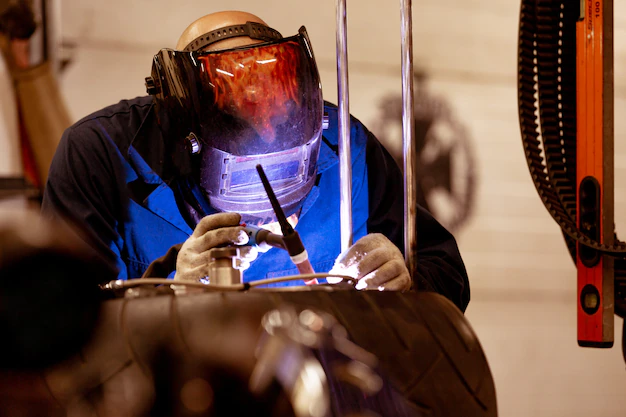How to Get a Welding Job? 9-Step Guide

Introduction
You’ve come to the right place if you’re considering making a profession out of welding. The number of jobs that require professional welders is growing, which means that individuals with the necessary abilities and a strong work ethic will have many options available.
I will guide you on How to Get a Welding Job. 9-Step Guide. This guide will help you through the seven critical steps to securing your dream welding career, regardless of whether you are a newbie hoping to enter into the business or an experienced welder seeking a new opportunity.
How to Become a Good Professional Welder
When we hear “welder,” we immediately think of welding. A welder heats metal parts to high temperatures to join them. Welders are metal maestros that build and repair complex machinery parts using blueprints, 3D models, and prototypes. Before welding, angle grinders, rulers, and other instruments are needed.
Precision is crucial in welding. Welders inspect every seam for defects. Handling equipment and weather needs technical competence and physical strength. Imagine the exhilaration of converting metal into art.
How can one enter this thrilling world? 6–12 months of intensive sparking and precision job training begin the route. So many welders learn by doing. Certifications like welding certifications can enhance earnings and job possibilities.
Before welding, one may be a welder fitter, pipe welder, or machine operator. Although stepping stones, these jobs are essential to welding abilities and expertise. Precision metalworking or business degrees can support formal education. General studies and auto technology degrees are unconventional yet valid.
If you like metal and imagination, welding is a great job. The job blends talent, craftsmanship, and ingenuity into a molten metal and creative symphony. Welders’ resumes are the best resource for apprentices.
What are the requirements to pursue a career as a welder?
The educational prerequisites for welding can differ depending on the employer and specific job position.
Here are the ten essential steps to becoming a certified welder.
- Step 1: Explore Welder Education
- Step 2: Acquire the Necessary Skills
Step 3: Develop Welder Skills
Step 4: Complete Relevant Training/Internship
Step 5: Certified Welding Inspector (CWI)
Step 6: Research Welder Duties
Step 7: Prepare Your Welder Resume
Step 8: Apply For the Welder Job
Step 9: Build a Strong Portfolio - step10: Orientation to the Training Site:
1. Explore Welder Education
The Welding Performance Qualification (WPQ) certification demonstrates your ability to carry out various welding procedures following a certain standard. To get a WPQ, you must show that you are proficient in welding by passing a test administered by an employer or a certified testing center.
- Typical Education for Someone Starting
- A high school diploma or equivalent diploma is required.
- Experience Gained While Employed in a Field That Is Closely Related None
- Training While on the Job Training While on the Job for a Moderately Long Term Number of Jobs, 2021 428,000
2. Acquire the Necessary Skills
Welding demands advanced arithmetic skills. Most vocations require math skills to calculate dimensions, analyze plans, draw sketches, and more. Some necessary math ability for the role is Spatial thinking.
3. Develop Welder Skills
Welding is a Skill That Requires Certain Abilities. Do You Think You Have What It Takes?
Competence in Mathematics.
Paying Attention to the Details.
Steady hands, as well as hand-eye coordination that is above average.
Power and stamina are essential qualities for athletes.
Capacity for Continuously Acquiring New Knowledge.
Capacity for effective communication and participation in team endeavors.
Consolidate Your Knowledge in These Areas, and You’ll Become a Better Welder!
4. Complete Relevant Training/Internship
The training site mainly aims to give interns hands-on welding engineering experience. The training program varies for each intern and company. However, each training facility should offer interns suitable training.
Assignments for the intern should be demanding and significant in welding engineering technology. Assignments should teach students and give them meaningful work at the site. The intern should watch and participate in every element of engineering as possible.
Tasks may include process planning, plant layout, volume planning, equipment justification, automation, supervision, maintenance, tooling, design, NDT and DT testing, and parameter creation. The intern should be rotated at least once to experience different welding engineering technology phases.
5. Orientation to the Training Site:
The intern should learn about the organization and operation of the training site. The student’s first week should include reviewing organizational charts, program plans, personnel regulations, procedure manuals, and other relevant material.
The training site plays a crucial role in internship supervision by providing adequate instruction and care to internships. The intern reports to an experienced supervisor. The supervisor should evaluate the intern’s skills and assign work accordingly.
6. Welding Inspector Certification (CWI)
Welders interested in pursuing careers as inspectors can participate in a CWI certification program made available by the American Welding Society (AWS). To become a Certified Welding Inspector (CWI), you must have previous welding experience and education and pass both a written and practical examination.
7. Prepare Your Welder Resume
You can update your résumé after joining a welding group. This can set you apart from other welders because your resume may be current and relevant to the opportunities you apply for. A well-written CV may demonstrate your dedication to welding, progress, welding skills, and career ambitions to companies. Updating your CV lets you showcase your welding passion and best workplace achievements.
8. Apply For Welder Job
How to Get a Welding Job? The first step to discovering welding employment is checking current job postings. Note what talents the employer wants and how long the position has been open while looking at these postings. This can tell you what skills the job requires and when the advertisement closes. Last, note the terminology job postings used to describe positions. This might help you write or update your job resume.
9. Build a Strong Portfolio
Showcasing your most excellent work and emphasizing your talents are key to building a solid portfolio. Choose a range of assignments that highlight your knowledge and adaptability. For each piece, give detailed descriptions and justifications. Adapt your portfolio to your sector and target market.
Include your contact details and a brief professional biography. Update your portfolio frequently with fresh work to demonstrate your development and relevancy.
10. Orientation to the Training Site:
Orientation introduces new hires to their duties, coworkers, and workplace. Practical orientation training helps new hires feel comfortable in their jobs, teams, and departments and informs them of business standards. New hires can ask questions and resolve concerns during orientation. It aims to make them more comfortable with their responsibilities.
The company’s streamlined, systematic approach to communicating tasks and expectations to a new employee makes orientation a smoother transition. Misunderstanding expectations can lead to employee attrition, but excellent exposure can help.
It also guarantees that new team members receive the same knowledge and training. This raises the chance of upfront communication of crucial information.
Conclusion
To be successful in your job search for a welder, you need a combination of technical knowledge, preparedness, and the ability to communicate effectively. You can improve your chances of finding a position in the welding sector that will fulfill your career goals if you pay attention to the advice in this article and demonstrate that you are skilled in welding.
FAQ’S
How to Get a Welding Job: My first job as a welder?
It would help if you typically had a high school diploma to get a job as a welder with no experience. A no-experience welding job is often part of an apprenticeship or trade school program that combines classroom instruction with practical job training.
Is welding easy to get into?
At first, it may be intimidating, but welding is not challenging to learn after throwing a few sparks. It will, however, take years of practice and miles of weld beads to be genuinely excellent at it.
Is welding worth it as a career?
Welders provide services to various industries, including manufacturing, transportation, and infrastructure. Working in a high-demand field can be beneficial, as it guarantees stable employment and higher wages because the skills of the trade are precious to employers.






